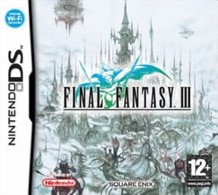Final Fantasy III (Nintendo DS) Second Opinion Review
By Phil Beveridge  08.06.2007
08.06.2007

In the past, we've seen many retro games that have been updated for the new generation, given a complete facelift, as well as a second chance in the spotlight... then failed. Being a 16 year old game originally designed for the Nintendo Famicom and never being released outside Japan, Final Fantasy III has been a highly anticipated game for the Nintendo DS. But can it live up to the franchise's name, and meet the expectations placed upon it by the modern market?
Firstly, this game is not just a minor update to the original, as we've seen with the Final Fantasy games for the Game Boy Advance. This is a fully blown remake, and you can tell that Square-Enix have been working hard on this beauty. Actually, you can even tell before you reach the main menu. You're treated to a glorious four-minute dual-screen FMV sequence which looks like it's been pulled straight from one of the modern Final Fantasy games. Even though it is only video, and also explains why it's one of the biggest DS carts in terms of size currently available, it's still a great way to get you immersed in the game right from the starting post.
The game starts by introducing our main protagonist, Luneth, stumbling across a cave opened by a freak earthquake one day, and finding himself trapped. After making his way through the cave, fighting a few monsters, finding items, and basically completing the tutorial for the game, Luneth encounters a giant talking crystal, telling him that he and three others are the chosen ones, and unless they restore the balance in the world, it is doomed for all eternity. Your standard role-playing game plotline, then. But before criticising it for being the same story as many other games of a similar genre, you must remember that the game is over 15 years old and first appeared on the NES in 1990. In fact, this is the only game in the main Final Fantasy series to have never been released in the western world, making it a very special game indeed.

How you control the game very much depends on your choices. If you're more of a traditional gamer, then you can play through the entire game just by using the buttons on the Nintendo DS, using the D-pad to select menu options, and so forth. Alternatively, all the same features used by the button control method can also be accessed using the touch screen alone, making this a very versatile system. Users can even choose to have a combination of the two completely different methods, to best suit their tastes. Here at Cubed3, we find the touch method the most efficient, and the ability to select options during battles by just tapping the menu item (such as 'Attack'), then simply tapping the enemy.
Soon after the Crystal of Light's plea, and through a number of strange coincidences, you end up meeting with the other three members of your party, and on your first task to save a village from an evil curse that's making everyone turn invisible. Arc is Luneth's childhood friend, Refia is a girl raised by a local blacksmith, and Ingus is a soldier working for King of Sasoon. Together, these four orphans' destinies have intertwined, and must become the Warriors of Light in order to vanquish the Cloud of Darkness, an evil being who wishes to, well, cover the world in darkness. What an appropriate name.
The battle system is a turn-based one seen in the early Final Fantasy games, rather than the modern 'Active Time Battle' system being used in games since Final Fantasy VII for the Sony Playstation. In fact, many say that the battle systems in the early Final Fantasy games were the basis for many other RPGs that followed it, and it shows. So simple, but it makes battles interesting when everything such as items and magic can be accessed from the in-battle menus. Like mentioned before, all the menus that are in the game are touch-screen compatible, adding that greater feeling of interactivity. However, you might want to use the D-pad method as well, as accidentally tapping the wrong monster in a battle could end up with very bad consequences for your party...

One of the major features of this particular game is the job system, which has been upgraded for this particular version. In order to have a successful and well-balanced team, you must assign each member of your party a certain job. You may want to assign a White Mage on your team (who specialises in healing and defensive magic), a Black Mage (who specialises in offensive magic), or a Warrior (who is the best at attacking, but has weak defence). Each job that can be assigned has certain strengths and weaknesses, and there are over 20 different unlockable jobs available as you progress through the game, giving your party the extra push that it needs to get to the finish.
Like any good role-playing game, it's got the traditional statistical element to it. The more you battle, the more experience you get. The more experience you get, the faster you level up. The higher the level you are, the more powerful your character is. It's an ancient tried-and-tested system, but still works just as well as decades ago. Each village allows you to buy items, such as potions and antidotes, as well as equipment shops allowing you to buy swords, armour, and so forth. Only certain items can be used by certain job classes though, so make your choices wisely. Magic works in a similar way to the equipment, allowing you to simply equip magic to a character, and remove it just as easily. And we must say, the attacking magic does produce some swish graphical eye-candy.
Now onto one of the topics that everyone wants to know about - What are the graphics like? We can safely say that these are some of the best graphics that we've seen on the Nintendo DS so far. The entire game has been recreated from its NES counterpart in full 3D, and looks marvellous. While not in battles, you can change your view of your surroundings by zooming in on your character. This helps you uncover hidden areas in dungeons and buildings, as certain items will sparkle when zoomed in on, and can be examined. Oh, and don't expect much dual-screen 3D action during the game, as it uses the graphic processing chips from both screens just to generate the 3D output on one of them. But having one of the screens with nothing on it make absolutely no difference to the gameplay whatsoever, and the touch-screen capabilities more than make up for the lack of dual-screen elements. As we've also seen previously from another Square-Enix developed game, Mario Hoops 3 on 3, they certainly know how to use the hardware well, and this is reflected in their upcoming Western Nintendo DS games such as Final Fantasy XII: Revenant Wings, Dragon Quest Monsters, or Heroes of Mana.

The graphics aren't the only thing to look forward to though if you've played the game before (even though it's only been released in Japan before now). Generally, Square-Enix has used their experience from 19 years of making Final Fantasy games to tweak and modify the game to create the best possible experience for the player. The story has been polished slightly (the original had four unnamed characters as the main heroes), things like the battle system have been improved, as well as making the choice of jobs fairer instead of one best job for each character.
Even the sound of the game has had a complete overhaul, under supervision of famous Japanese composer Nobuo Uematsu, responsible for nearly all the audio through Final Fantasy's history. The music has been completely rescored for this remake, and helps to provide the right kind of atmosphere in the different situations throughout the game.
But wait, there are more new additions! To use the Nintendo DS's hardware even further, the developers are making use of the Nintendo Wi-Fi Connection in a system called 'Moogle Mail'. By using this, you can send messages to other Final Fantasy III players, and... well, that's about it. It could have been implemented a bit better, but I guess a fully Wi-Fi co-op Final Fantasy game is a little bit too much to ask from Square-Enix at the moment. But you can use this mail feature to send messages to other minor characters in the game in order to unlock Nintendo DS-exclusive side quests and missions, so it's not all bad.
But apart from all the extra additions, you have to appreciate this game for what it is - a deep and refreshing role-playing game, from the people who have been making RPGs for over 20 years. So you'd better get ready to do plenty of levelling, healing, battling and equipping, because you're going to need it. Even if the game is 16 years old, that makes no difference whatsoever to the quality of the gameplay. You have a solid 25-hour story here at least, without going into any of the side quests or extras. It is no surprise that this has received a very warm welcome in the United States so far and is currently riding high in the European charts as well.

Cubed3 Rating
Exceptional - Gold Award

So, to answer the question put forward in the first paragraph as simply as possible - Yes. Remakes sometimes can fail, especially when graphics are modernised for the new generation of games, and so forth. But this game is not one of those games. It succeeds with flying colours. Even if this game is over 15 years old, it still delivers a fantastic story, challenging gameplay, and some of the best graphics that we've ever seen on Nintendo's latest handheld console.

![]() 5/10
5/10
![]() 9/10
(107 Votes)
9/10
(107 Votes)
 Out now
Out now  Out now
Out now  Out now
Out now  Out now
Out now Comments
Comments are currently disabled

 Sign In
Sign In Game Details
Game Details Subscribe to this topic
Subscribe to this topic Features
Features





 Top
Top

